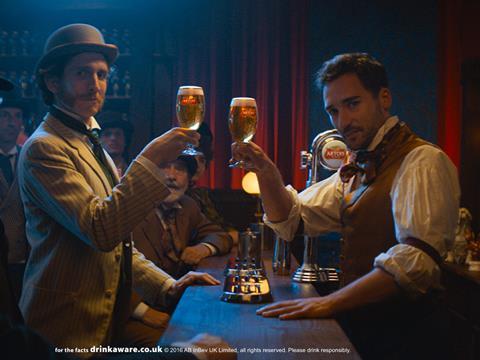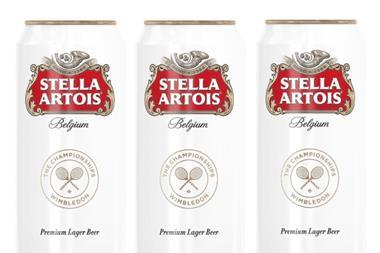
1 (1)
Stella Artois
Sales: £537.5m Growth: -2.8%
It’s clear where blame lies for Britain’s biggest booze brand’s £15.5m decline: Stella Cidre, credited with driving cider’s explosive growth (and inspiring a slew of copycats from rival lagers) after its launch in 2011, has gone sour. It’s lost more than a third of its sales, or £21.1m, the greatest loss of any cider in this year’s ranking.
“The numbers don’t lie; the last 12 months have been tough,” says AB InBev marketing director Nick Robinson. “Cidre needs to make a big step in terms of being as relevant as it was back at launch in terms of its look and feel. Given the cider environment is more competitive than it’s ever been, retailers are making choices about which are going to be the winning brands in that very cluttered category. It expanded very fast; there were a lot of new entrants.”
Cidre’s loss of space has been its rivals’ gain. Kopparberg (20) is up £14.5m; Thatchers (73) and Westons (60) are up £6.5m and £2.1m respectively. Note that all three are at premium price points, with a litre of Thatchers fetching an average of 14p more than Cidre’s £2.53, and Westons and Kopparberg at premiums of 82p and £1.01 respectively.
As this growth shows, drinkers are prepared to pay a higher price for these brands. Conversely, Cidre’s 5.5% rise in average price appears to have deterred drinkers. Robinson suggests Cidre’s move into cans has had a detrimental effect on the brand’s standing in the mind of consumers and says a new bottle design and summer-long marketing campaign that kicked off this month is aimed at addressing this.
“We and the retailers are trying to re-establish Cidre as a bottled brand,” he says. “Bottles is where we have our highest repeat rates. We are not going to come out of cans because it’s a reasonable proportion of our overall volume, but the focus is going to be primarily around the bottles in terms of building the brand’s premium nature, which is consistent with the overall Stella brand value.”
One value driver in recent years has been new flavour variants. Raspberry, launched in May 2014, sells for an average of £3.55 a litre, but has seen 43.4% of the value it racked up in its first year on shelf wiped out. It’s now worth £6.7m. Peach and Elderflower, launched in February, carry a similar premium and are the only two products in the range in growth. They’re now worth £3.9m combined. But the future of each variant is by no means guaranteed. “There’s space for five variants at the moment, but I don’t believe there’s space for any more,” says Robinson.
When it comes to lager, the focus is also on the core 4.8% abv product, which accounts for £475m of the overall value. It’s in fine fettle too, having racked up an extra £14.1m (3.1%), the second greatest growth of any top 100 lager after Corona (31). The growth has been driven by a slight dip in average price (in reflection of growing use of larger multipack deals), the brand’s new Be Legacy campaign and sponsorship of Wimbledon, and drinkers trading up from standard to premium lager.
Standard lagers such as Carlsberg (7) - delisted by Tesco last October - are suffering from reduced shelf space in the mults, adds Robinson, a pattern that’s paying off for Stella. “Have consumers come out of Carlsberg into Stella? I assume they probably have, but it would be a conscious tradeup,” he says. “Consumers are gravitating towards premium brands that have more value than the standard lager brands. That’s a clear consumer trend in the on and off trade.”
That trend has also hit Stella 4 hard. It’s down 28.8% to £21.1m. “Stella 4 has had a tough last 12 months,” says Robinson. “It’s lost some space, on particular SKUs such as 12 and 18 packs. The primary focus will continue to be 4.8% abv variant but it’s still seen by us and retailers as having a role in the portfolio.”
For how long, remains to be seen.




No comments yet